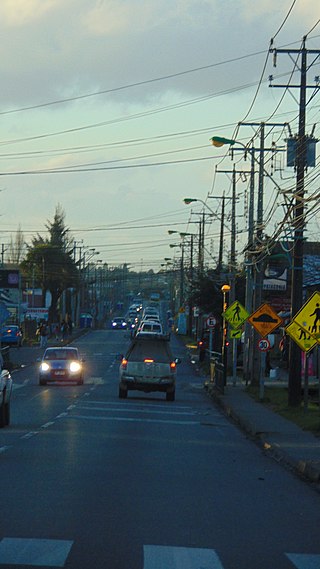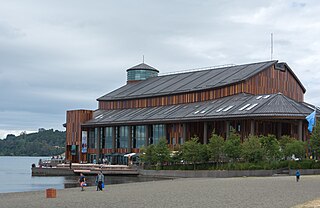Notes
- 1 2 3 "Ciudades, pueblos, aldeas y caceríos 2019" (PDF) (in Spanish). National Statistics Institute. 2019. Retrieved November 1, 2020.
Los Pellines | |
|---|---|
| Region | Los Lagos |
| Province | Llanquihue |
| Municipality | Llanquihue |
| Commune | Llanquihue |
| Government | |
| • Type | Municipality |
| • Alcalde | Victor Angulo Muñoz (Ind.) |
| Population (2017 [1] ) | |
| • Total | 1,159 |
| Sex | |
| • Men | 569 |
| • Women | 590 |
| Time zone | UTC-4 (Chilean Standard) |
| • Summer (DST) | UTC-3 (Chilean Daylight) |
| Area code | Country + town = 56 + 65 |
Los Pellines is a small town (Spanish : pueblo) in Los Lagos Region, Chile. [1] It lies along Chile Route 5 south of Frutillar and north of Llanquihue about 3.5 km west of Llanquihue Lake.

The Valdivian temperate forests (NT0404) is an ecoregion on the west coast of southern South America, in Chile and Argentina. It is part of the Neotropical realm. The forests are named after the city of Valdivia. The Valdivian temperate rainforests are characterized by their dense understories of bamboos, ferns, and for being mostly dominated by evergreen angiosperm trees with some deciduous specimens, though conifer trees are also common.
Fitzroya is a monotypic genus in the cypress family. The single living species, Fitzroya cupressoides, is a tall, long-lived conifer native to the Andes mountains and coastal regions of southern Chile, and only to the Argentine Andes, where it is an important member of the Valdivian temperate forests. Common names include alerce, lahuén, and Patagonian cypress. The genus was named in honour of Robert FitzRoy.

Alerce is a Chilean town in the communes of Puerto Montt and Puerto Varas in Llanquihue Province, Los Lagos Region.

Los Lagos Region is one of Chile's 16 regions, which are first order administrative divisions, and comprises four provinces: Chiloé, Llanquihue, Osorno and Palena. The region contains the country's second-largest island, Chiloé, and the second-largest lake, Llanquihue. Its capital is Puerto Montt; other important cities include Osorno, Castro, Ancud, and Puerto Varas. Los Lagos Region is considered part of Patagonia.

Frutillar is a city and commune located in southern Chile, Chilean Patagonia, in Llanquihue Province, within the Los Lagos Region, the lake district. The bay of Frutillar is placed on the banks of Lake Llanquihue, the largest lake entirely within Chile. Frutillar is known as the "City of Music", and since 2017 is part of the UNESCO Creative Cities Network (UCCN), becoming the first Chilean city to be nominated, as well as the southernmost Creative City of Music in the world.

Llanquihue Province is one of four provinces of the Chilean region of Los Lagos (X). Its capital is Puerto Montt. Chile's second largest lake, Lake Llanquihue, is located in the province as well as four volcanoes: Osorno, Calbuco, Puntiagudo and Cerro Tronador.

Punucapa is a hamlet of pre-Hispanic origin in Los Ríos Region, Chile. Its isolated location by the Cruces River and the Valdivian Coastal Range has made the village an ecotourism attraction. The wetlands of the river is the home to thousands of birds; the black-necked swan is the most emblematic. In 2017 Punucapa had a population of 119 inhabitants up from 75 in 2002.

Reloncaví Estuary is a fjord off Reloncaví Sound, located in the Los Lagos Region of Chile. Several National Parks and Wilderness Areas are situated in the vicinity of this fjord. Among them are: Alerce Andino National Park, Hornopirén National Park, Vicente Pérez Rosales National Park, Llanquihue National Reserve and the Cochamó Valley. The Yate Volcano towers above this fjord. The Puelo River empties into this estuary. It also receives the outflow of the Todos los Santos Lake through the short tortuous Petrohué River.

Niebla is a coastal Chilean town close to the city of Valdivia, Valdivia Province, Los Ríos Region. Niebla is located on the northern edge, at the mouth of the Valdivia River, across from Corral. Niebla's beach and folk market are popular tourist destinations during the summer, together with the ruins of a Spanish colonial fort and its museum.

The Archdiocese of Puerto Montt is a Metropolitan See of the Roman Catholic church, in Chile. Its suffragan dioceses are: Osorno, San Carlos de Ancud and Punta Arenas.

Petrohué Waterfalls is a chute-type waterfall in the upper reach of Petrohué River in Chile, a short distance downstream of the source of this river in Todos los Santos Lake. This waterfall is inside the Vicente Pérez Rosales National Park, close to the road leading to the Petrohue locality on lake Todos los Santos. Tourists on the international route between Puerto Montt in Chile and Bariloche in Argentina are generally offered a stop for a walk to enjoy the sights.
Chonchi is a Chilean town and commune located in Los Lagos Region. The commune consists of the town of Chonchi and the following villages:

Calbuco is a city and commune in southern Chile administered by the Municipality of Calbuco. Administratively Calbuco belongs to the Llanquihue Province of Los Lagos Region. The origin of the city was the Spanish Fort Calbuco founded in 1603, and became later an important fish market. The archaeological site of Monte Verde lies within the commune.

Llanquihue is a Chilean commune and city in Llanquihue Province, Los Lagos Region. The city lies on the western shore of Lake Llanquihue, where the Maullín River starts. It is located 7 kilometres (4.3 mi) north of Puerto Varas and 19 kilometres (12 mi) south of Frutillar and is connected to both cities by Chile Highway 5.

The Teatro del Lago is a stage theatre and concert hall located in Frutillar, Los Lagos Region, Chile.
From 1850 to 1875, some 30,000 German immigrants settled in the region around Valdivia, Osorno and Llanquihue in Southern Chile as part of a state-led colonization scheme. Some of these immigrants had left Europe in the aftermath of the German revolutions of 1848–49. They brought skills and assets as artisans, farmers and merchants to Chile, contributing to the nascent country's economic and industrial development.
Santo Domingo Formation is a mainly marine Miocene sedimentary formation located in south–central Chile. The formation was defined by R. Martínez Pardo and Mario Pino in 1979 and named after the roadcut locality they studied about 19 kilometres (12 mi) southeast of Valdivia. Sediments of the formation accumulated in Valdivia and Osorno–Llanquihue Basin.
Pargua is a village in the commune of Calbuco, in Los Lagos Region of Chile. It is located on the northeast side of the Chacao Channel. Pargua is on Route 5 and a ferry connects the village with the village of Chacao, Ancud Comuna at the northern end of Chiloé Island. There are plans to build the Chacao Channel bridge across the channel to replace the ferry.

Nueva Braunau is a Chilean village located in the commune of Puerto Varas, Southern Chile. It was founded mostly by Austro-Hungarian settlers from Braunau, Bohemia on 15 August 1877. The settlement originated as part of the German colonization of Valdivia, Osorno and Llanquihue.

The last glacial period and its associated glaciation is known in southern Chile as the Llanquihue glaciation. Its type area lies west of Llanquihue Lake where various drifts or end moraine systems belonging to the last glacial period have been identified. The glaciation is the last episode of existence of the Patagonian Ice Sheet. Around Nahuel Huapi Lake the equivalent glaciation is known as the Nahuel Huapi Drift.